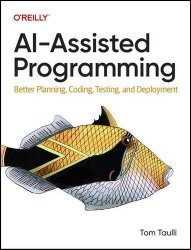AI-Assisted Programming: Better Planning, Coding, Testing, and Deployment
- Добавил: literator
- Дата: 15-04-2024, 06:49
- Комментариев: 0
 Название: AI-Assisted Programming: Better Planning, Coding, Testing, and Deployment
Название: AI-Assisted Programming: Better Planning, Coding, Testing, and DeploymentАвтор: Tom Taulli
Издательство: O’Reilly Media, Inc.
Год: 2024
Страниц: 225
Язык: английский
Формат: pdf (true)
Размер: 10.87 MB
Get practical advice on how to leverage AI development tools for all stages of code creation, including requirements, planning, design, coding, debugging, testing, and documentation. With this book, beginners and experienced developers alike will learn how to use a wide range of tools, from general-purpose LLMs (ChatGPT, Gemini, and Claude) to code-specific systems (GitHub Copilot, Tabnine, Cursor, and Amazon CodeWhisperer).
You'll also learn about more specialized generative AI tools for tasks such as text-to-image creation.
Author Tom Taulli provides a methodology for modular programming that aligns effectively with the way prompts create AI-generated code. This guide also describes the best ways of using general purpose LLMs to learn a programming language, explain code, or convert code from one language to another.
This book examines:
• The core capabilities of AI-based development tools
• Pros, cons, and use cases of popular systems such as GitHub Copilot and Amazon CodeWhisperer
• Ways to use ChatGPT, Gemini, Claude, and other generic LLMs for coding
• Using AI development tools for the software development lifecycle, including requirements, planning, coding, debugging, and testing
• Prompt engineering for development
• Using AI-assisted programming for tedious tasks like creating regular expressions, starter code, object-oriented programming classes, and GitHub Actions
• How to use AI-based low-code and no-code tools, such as to create professional UIs
Chapter 1, “New World for Developers”: This chapter kicks off with a look into how generative AI is changing the game for coders. It talks about how these AI tools are helping developers think more about the big picture and less about the nitty-gritty of coding. The chapter also takes a stroll through the history of programming languages. There are also details about the advanced AI technologies like GPT-4.
• Chapter 2, “How AI Coding Technology Works”: The chapter starts off by explaining generative AI and why transformer models and large language models are big deals in the programming world. To top it off, there’s a walkthrough of OpenAI’s Playground, showing how you can play around with these AI models and tweak them to suit your coding needs.
• Chapter 3, “Prompt Engineering”: The information here is critical to using AI-assisted programming tools. This chapter is packed with practical tips, like dealing with wordy or confusing prompts and deterring AI from making stuff up. Plus, it breaks down the key parts of a prompt and shows you how to use them effectively.
• Chapter 4, “GitHub Copilot”: This chapter is a walkthrough of this powerful tool. There’s a look at the core features like creating code with comments, Chat, and using an AI-powered command-line interface. There is also coverage of customizing the system for proprietary codebases.
• Chapter 5, “Other AI-Assisted Programming Tools”: This chapter details the other top AI-assisted programming tools like Amazon CodeWhisperer, Google’s Duet AI, and Replit to name just a few.
• Chapter 6, “ChatGPT and Other General-Purpose LLMs”: This covers how to use these tools for tasks like handling regular expressions, starter code, and GitHub Actions.
Chapter 7, “Ideas, Planning, and Requirements”: The focus here is on using chatbots to kick off software projects. This involves topics like brainstorming, market research, requirements documents, and test-driven development.
• Chapter 8, “Coding”: This chapter goes through common scenarios for development, whether working with APIs, using modular programming, or refactoring. There’s also a look at handling functions and object-oriented programming.
• Chapter 9, “Debugging, Testing, and Deployment”: This chapter is about the less glamorous parts of development. It covers topics like fixing bugs, using AI-assisted programming tools for code reviews, making unit tests, and describing pull requests.
• Chapter 10, “Takeaways”: This is a wrap-up of the book, emphasizing the main points.
Who Should Read This Book:
This book is for any developer, whether you’re just starting out or you’ve been in the game for many years.
Скачать AI-Assisted Programming: Better Planning, Coding, Testing, and Deployment
Внимание
Уважаемый посетитель, Вы зашли на сайт как незарегистрированный пользователь.
Мы рекомендуем Вам зарегистрироваться либо войти на сайт под своим именем.
Уважаемый посетитель, Вы зашли на сайт как незарегистрированный пользователь.
Мы рекомендуем Вам зарегистрироваться либо войти на сайт под своим именем.
Информация
Посетители, находящиеся в группе Гости, не могут оставлять комментарии к данной публикации.
Посетители, находящиеся в группе Гости, не могут оставлять комментарии к данной публикации.
